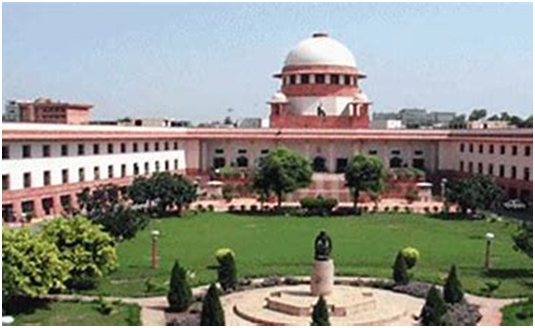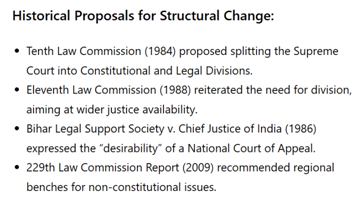

SUPREME COURT OF INDIA
SUPREME COURT OF INDIA

Syllabus: General Studies Paper-II: Governance, Constitution, Polity, Social Justice, International Relations.
Sub-Topics:
-
- Role and Structure of the Supreme Court in India
- Constitutional Powers and Responsibilities of the Supreme Court
- Judicial Reforms and Challenges Faced by the Supreme Court
- Judicial Activism and Public Interest Litigations (PILs)
Tags: #Supreme Court #JudicialReforms#ConstitutionalLaw#LegalSystem #IndianJudiciary#Jurisdiction#StructuralReforms#ConstitutionBench #DivisionBench #LawCommission#HistoricalEvolution #RegionalBenches#JudicialAccessibility#LegalHistory #JudicialOverhaul#ConstitutionalInterpretation#AdvisoryJurisdiction #AppellateJurisdiction.
Why in The News?
CJI Justice Chandrachud rephrased for revamping of supreme court.
| Evolution of the Supreme Court
Colonial era: Three Supreme Courts in Bombay, Calcutta, and Madras. 1773: Established under the Regulating Act. 1861: Indian High Courts Act replaces Supreme Courts with High Courts. 1935: Government of India Act establishes the Federal Court. 1950: Birth of the current Supreme Court under Article 124. |
Three Jurisdictions of the Supreme Court:
A. Original, Appellate, and Advisory roles under the Constitution. B. Dual role as a Constitutional Court and Court of Appeal.
Bench Configurations: A. Constitution Benches: Five, seven, or nine judges for constitutional law issues. B. Division Benches: Two judges for various topics, ensuring a broad jurisdiction.
|
With its diverse jurisdictions, the Supreme Court of India has played a pivotal role in interpreting the Constitution and serving as a Court of Appeal. However, the current structure faces challenges, with a staggering caseload and a need for structural reforms.
ISSUE:


- Current backlog: 79,813 cases pending before 34 judges.
- Demand for structural changes and Chief Justice D.Y. Chandrachud’s proposal.
Current Challenges:
The Indian judiciary, a cornerstone of our democratic framework, plays a pivotal role in upholding the rule of law and safeguarding the rights of citizens. However, the system grapples with several challenges that hinder its optimal functioning.
- Addressing Judicial Delays
An overwhelming number of pending cases, and the insufficiency of judges in proportion to the population exacerbates the problem, necessitating urgent measures such as expediting the appointment process and augmenting the number of judges.
| According to the National Judicial Data Grid, as of December 2022, there were approximately 48 million pending cases in the Supreme Court, High Courts, and subordinate courts across India.
The data indicates that it takes an average of 15 years for a civil case to reach a conclusion in the Supreme Court, while criminal cases can take around eight years. |
Additionally, outdated litigation procedures and complex legal frameworks contribute to the prolongation of court proceedings. Streamlining legal procedures and modernizing legislation emerge as critical steps to alleviate the burden on courts and enhance the overall efficacy of the judicial system.
Insufficient Specialization and Expertise
The absence of dedicated courts for specific legal domains leads to inefficiencies in handling complex cases. Specialized expertise is imperative for addressing issues such as commercial disputes, intellectual property, and environmental matters.
Corruption and Accountability
- Balancing judicial independence with accountability is crucial for maintaining public trust. The Indian judicial system is equally corrupted. There is no system of accountability. The media also do not give a clear picture on account of the fear of contempt. There is no provision for registering an FIR against a judge taking bribes without obtaining the permission of the Chief Justice of India.
| The various recent scams like the CWG scam, 2G scam, and Adarsh Society scam, including rapes and other atrocities in the society, etc. have emphasized both the conduct of politicians and public dignitaries, including the common man and also the drawbacks in the functioning of Indian judiciary |
Lack of transparency: The Right to Information (RTI) Act is totally out of the ambit of the legal system. Thus, in the functioning of the judiciary, substantial issues like the quality of justice and accountability are not known properly.
Concerns regarding the transparency of judge appointments, transfer policies, and disciplinary proceedings have raised questions about the efficacy of current mechanisms
Multiplicity of Language and Culture:
The existing cultural and linguistic diversity poses a significant challenge to the development of a unified judicial structure in India. Unlike many other countries, there’s no uniform language for subordinate courts nationwide. This diversity extends to service conditions, salaries, and other aspects, creating a distinct separation between judicial cadres in various states and Union Territories.
| Efforts to revamp the lower judicial structure, which handles nearly two crore cases annually, have been hindered by this linguistic diversity |
The Appointment of Judges
The collegium system, responsible for judge selection, has faced scrutiny for its perceived lack of transparency. Examining alternative appointment models involving broader stakeholder participation and transparent selection criteria can enhance the judiciary’s strength and transparency. Simultaneously, mechanisms for judicial accountability, such as efficient investigative and disciplinary protocols, should be improved to bolster public trust.
| The major cause of delay, the report claims is that judges hear between 20 and 150 cases a day, averaging 70 hearings per day for a judge.
Increasing workload: From 8 judges in 1950 to 34 in 2019. |
Improving Access to Justice
Equal access to justice, a fundamental tenet of democracy, faces challenges in marginalized communities, economically disadvantaged individuals, and remote regions.
Judicial Infrastructure and Technology
Inadequate infrastructure and underutilization of technology impede the judiciary’s effectiveness. Allocating resources for modernization, including sufficient courtrooms, updated libraries, and advanced technology integration. The adoption of digital technologies, such as online case management and virtual hearings, can significantly improve accessibility and efficiency.
The Required Judicial Reforms :
Perceptions of inefficiency and doubt surrounding the judiciary necessitate proactive reforms.
- Transparency, accountability, and efficiency should be prioritized through measures such as disseminating judicial decisions, establishing independent entities for examining accusations against judges and implementing comprehensive ethics guidelines.
- Efforts to mitigate judicial delays, enhance specialization, ensure accountability, and improve access to justice are essential for cultivating a judiciary that upholds the principles of democracy. Engaging with these issues with the public is not only necessary but also for the preservation of justice and the democratic fabric of our nation.
- Reduce the Structural gap and the call for a Final Court of Appeal and a permanent Constitution Bench. The ongoing Constitution Bench (V. Vasanthkumar v. H.C. Bhatia) addresses structural issues.
- Possibility of designating appeal benches as regional benches.
Way Forward:
The Supreme Court of India, with its rich history, faces the challenge of an overburdened judiciary. Structural reforms, as proposed by past commissions and the current Chief Justice, are crucial for ensuring judicial stability, consistency, and greater accessibility for citizens. The ongoing discussions and the Constitution Bench’s analysis present an opportunity for meaningful changes in the apex court’s structure. It requires the need for a balanced approach to ensuring efficient administration while upholding judicial independence.
Supreme Court of India Overview:
Appointment and Tenure:
|
Expected Mains Question:
“Examine the challenge of balancing judicial independence and accountability in India, focusing on transparency issues in judge appointments and disciplinary proceedings. Propose concise reforms to address these concerns and enhance public trust.”Top of Form
Prelims Question:
- “In the context of the Supreme Court of India, consider the following statements:
- The power of the President to seek the Supreme Court’s opinion under Article 143 includes matters related to pre-constitution treaties.
- The Second Judges Case (1993) established the norm that the senior-most judge of the Supreme Court should be appointed as the Chief Justice of India.
Which of the statements is/are correct?”
- A) Only 1 B) Only 2 C) Both 1 and 2 D) Neither 1 nor 2
